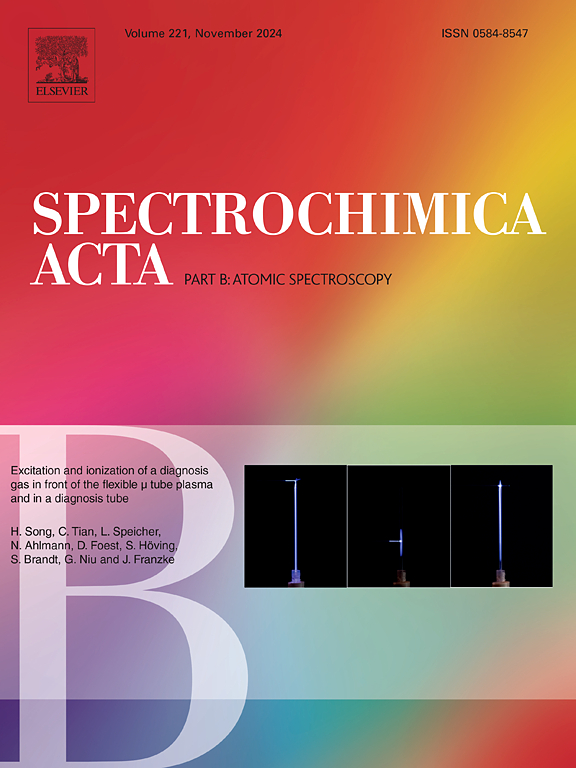用于元素成像的长脉冲激光诱导击穿光谱:对人牙齿的评价
IF 3.8
2区 化学
Q1 SPECTROSCOPY
引用次数: 0
摘要
激光诱导击穿光谱(LIBS)是一种通过分析元素发射进行化学成像的实用技术。事实证明,利用长脉冲激光可增强 LIBS 在水和空气中的检测能力。然而,长脉冲 LIBS 在成像中的应用仍有待探索。在本研究中,我们使用了脉宽为 100 ns 的激光进行 LIBS 成像,以人类牙齿为样本获取元素分布,并进行性能评估。结果表明,在长脉冲 LIBS 的作用下,可以有效地分辨出边界清晰的牙层。与 10-ns 脉冲激光相比,长脉冲激光下的 LIBS 发射普遍增强,从而提高了化学成像能力。这种增强可能归因于通过长时间激发实现了更高的质量消耗。在检查等离子体特性后发现,长脉冲 LIBS 对齿层的变化表现出更高的灵敏度。此外,在长脉冲 LIBS 下,分子发射被明显放大。利用这些分子发射还可以跟踪成分分布,并通过参考元素与分子之间的相关性提取更多信息。因此,利用长脉冲激光可以作为一种有效的方法,在 LIBS 分析中增强化学成像,同时提供分子绘图等其他选择。本文章由计算机程序翻译,如有差异,请以英文原文为准。

Long-pulsed laser-induced breakdown spectroscopy for elemental imaging: An evaluation with human teeth
Laser-induced breakdown spectroscopy (LIBS) is a practical technique for chemical imaging by analyzing elemental emissions. The utilization of long-pulsed lasers has been proven to enhance LIBS detection in water and air. However, the application of long-pulsed LIBS in imaging remains unexplored. In this study, we employed a laser with a pulse width of 100 ns for LIBS imaging to obtain elemental distribution using a human tooth as sample for performance evaluation. It is demonstrated that the tooth layer can be effectively resolved with distinct boundaries under the long-pulsed LIBS. When compared with a 10-ns pulsed laser, the LIBS emissions were generally enhanced under the long-pulse laser, resulting in improved chemical imaging capabilities. This enhancement might be attributed to higher mass consumption achieved through prolonged excitation. After examining plasma properties, it was found that the long-pulsed LIBS exhibited higher sensitivity towards changes in tooth layers. Furthermore, the molecular emission was significantly amplified under long-pulsed LIBS. The compositional distribution is also trackable using these molecular emissions, and more information could be extracted by referencing the correlation between element and molecules. Therefore, utilizing a long pulse laser can serve as an effective approach to enhance chemical imaging in LIBS analysis while providing alternative options such as molecular mapping.
求助全文
通过发布文献求助,成功后即可免费获取论文全文。
去求助
来源期刊
CiteScore
6.10
自引率
12.10%
发文量
173
审稿时长
81 days
期刊介绍:
Spectrochimica Acta Part B: Atomic Spectroscopy, is intended for the rapid publication of both original work and reviews in the following fields:
Atomic Emission (AES), Atomic Absorption (AAS) and Atomic Fluorescence (AFS) spectroscopy;
Mass Spectrometry (MS) for inorganic analysis covering Spark Source (SS-MS), Inductively Coupled Plasma (ICP-MS), Glow Discharge (GD-MS), and Secondary Ion Mass Spectrometry (SIMS).
Laser induced atomic spectroscopy for inorganic analysis, including non-linear optical laser spectroscopy, covering Laser Enhanced Ionization (LEI), Laser Induced Fluorescence (LIF), Resonance Ionization Spectroscopy (RIS) and Resonance Ionization Mass Spectrometry (RIMS); Laser Induced Breakdown Spectroscopy (LIBS); Cavity Ringdown Spectroscopy (CRDS), Laser Ablation Inductively Coupled Plasma Atomic Emission Spectroscopy (LA-ICP-AES) and Laser Ablation Inductively Coupled Plasma Mass Spectrometry (LA-ICP-MS).
X-ray spectrometry, X-ray Optics and Microanalysis, including X-ray fluorescence spectrometry (XRF) and related techniques, in particular Total-reflection X-ray Fluorescence Spectrometry (TXRF), and Synchrotron Radiation-excited Total reflection XRF (SR-TXRF).
Manuscripts dealing with (i) fundamentals, (ii) methodology development, (iii)instrumentation, and (iv) applications, can be submitted for publication.

 求助内容:
求助内容: 应助结果提醒方式:
应助结果提醒方式:


